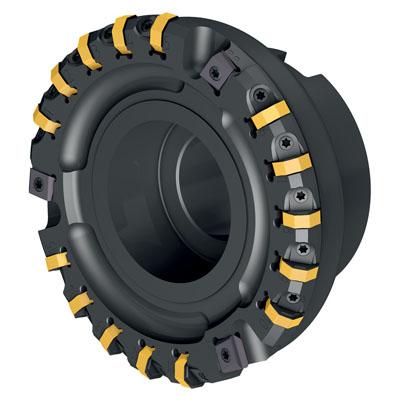
Walter has unveiled its M2025/M2026 octagon finishing facemills designed to reporedly deliver superior surface quality on large cast iron components. For these types of components, optimal sealing surface function can only be guaranteed when the surfaces are completely flat, and the new finishing mill tool ranges are built to produce that result. Plus, their high feeds and cutting speeds cut processing times and their ease of handling reduces setup requirements, saving time and cost.
These facemills are equipped with efficient 16-edged octagonal peripheral inserts and three, 4-edged, wiper inserts. The basic shape of the wiper inserts is negative, while the cutting edge geometry is positive. Convex edge wiper inserts ensure a high level of surface quality. All inserts are precision ground and the cutter bodies, likewise, feature precision insert seats, and cutting edges can be changed rapidly thanks to the wedge clamping of the octagonal inserts. Tool setup savings are gained because no adjustment of the wiper cutting edges is necessary.
In addition, process reliability is enhanced by the highly precise design and manufacture of the inserts and the tool body. The inserts, which are completely ground, are available in grades WAK15, WKP25S and WHH15, and are particularly suitable for cast iron workpieces.
Contact Details
Related Glossary Terms
- flat ( screw flat)
flat ( screw flat)
Flat surface machined into the shank of a cutting tool for enhanced holding of the tool.
- milling machine ( mill)
milling machine ( mill)
Runs endmills and arbor-mounted milling cutters. Features include a head with a spindle that drives the cutters; a column, knee and table that provide motion in the three Cartesian axes; and a base that supports the components and houses the cutting-fluid pump and reservoir. The work is mounted on the table and fed into the rotating cutter or endmill to accomplish the milling steps; vertical milling machines also feed endmills into the work by means of a spindle-mounted quill. Models range from small manual machines to big bed-type and duplex mills. All take one of three basic forms: vertical, horizontal or convertible horizontal/vertical. Vertical machines may be knee-type (the table is mounted on a knee that can be elevated) or bed-type (the table is securely supported and only moves horizontally). In general, horizontal machines are bigger and more powerful, while vertical machines are lighter but more versatile and easier to set up and operate.
- wiper
wiper
Metal-removing edge on the face of a cutter that travels in a plane perpendicular to the axis. It is the edge that sweeps the machined surface. The flat should be as wide as the feed per revolution of the cutter. This allows any given insert to wipe the entire workpiece surface and impart a fine surface finish at a high feed rate.

